Three-Dimensional Distribution of Arctic Aerosols Based on CALIOP Data
Abstract
1. Introduction
2. Materials and Methods
2.1. Data Sources
2.2. Methodology
3. Results and Discussion
3.1. Distribution of Arctic AOD from CALIOP Observations
3.1.1. Validation of CALIOP AOD
3.1.2. Seasonal AOD Distribution of the Arctic
3.2. Characteristics of Different Aerosol Types over the Arctic
3.2.1. Proportions and Trends of Different Aerosol Types in 2006–2021
3.2.2. Distribution of Different Aerosol Types over the Arctic
3.2.3. Three-Dimensional Structure of FoOs of Important Aerosol Types in Different Areas
4. Conclusions
- Overall, the CALIOP AOD exhibits a high level of agreement with AERONET AOD, with a correlation coefficient of approximately 0.67 and an RMSE of less than 0.1. There is a slight underestimation of CALIOP AOD over the Arctic; the underestimation during late spring and early summer is more pronounced. This indicates that the inversion algorithm for the AOD of CALIOP typically ignores some tenuous layers, especially during wet conditions over the Arctic. In addition, the ability of CALIOP to retrieve AOD varies under different underlying surface and topographic conditions.
- The AOD is higher over land than the ocean and decreases as the latitude increases over the Arctic in all seasons. The average AOD over the Arctic displays distinct seasonal variability, and it is highest during winter, followed by spring, autumn, and summer. In addition, the maximum AOD loading is pronounced in northern Siberia during summer due to the frequent wildfires there.
- PD, dust, and CM prominently dominate the aerosol composition over the Arctic during 2006–2021, while the proportion of CC in the Arctic is minimal. The highest aerosol loading of PD and dust is observed in spring due to long-range transport from Asia and Africa. In summer, wildfire contributes significantly to ES loading. In autumn and winter, CM, dust, and PD make up the main composition of aerosols, with significant local contributions from sea salt and biogenic aerosols originating in the Arctic Ocean.
- There are increasing trends in the FoOs of CM and dust and decreasing trends in the FoOs of PD, PC, and DM. Overall, these trends are mainly influenced by Arctic amplification, which has affected sea ice coverage and atmospheric circulation patterns and thus influenced the emission of these aerosol types in the Arctic. It is also worth noting that no significant trend in the FoOs of ES was observed during warmer summers. This is likely due to the rising total aerosol load over the Arctic, which limits ES proportions.
- The vertical mixing ability varies among different types of aerosols. Dust and PD are mainly concentrated above 4 km, while CM and DM are mainly detected below 3 km. The FoOs of ES increase with altitude, reaching a maximum between 2 and 3 km. The vertical distribution patterns of the same aerosol type show little seasonal variation, which indicates that the physicochemical properties of aerosols have a greater impact on their vertical mixing ability than aerosol quantity. However, the prevalent aerosol type in some seasons may influence the formation of related aerosol types, thereby affecting their vertical distribution.
- The dominant aerosol type at different altitudes varies by season over the Arctic below 6 km. In winter, dust transport from Asia covers much of the Arctic. This transport continues until spring, contributing to the formation of PD. In summer, ES from forest fires dominates the middle troposphere, and locally sourced dust and remaining ES become significant in autumn, with PD aerosols forming through the mixing of dust and ES in heavily polluted areas. This reveals that dust, ES, and PD are widely distributed over the Arctic. At 2–4 km, PC and CM dominate land and sea regions, respectively, in all seasons, while transported dust is notably detected in areas like northeastern Siberia and northern Alaska.
- Substantial amounts of dust, PD, and ES come from local sources, specifically Greenland, eastern Siberia, and middle Siberia, respectively. Arctic amplification and human activities not only contribute to the emission of these types of aerosols but also accelerate their horizontal spread. In addition, these aerosols tend to accumulate further north in the Arctic and then affect a broader region in the Arctic.
Author Contributions
Funding
Data Availability Statement
Acknowledgments
Conflicts of Interest
References
- Shu, Q.; Wang, Q.; Årthun, M.; Wang, S.; Song, Z.; Zhang, M.; Qiao, F. Arctic Ocean Amplification in a Warming Climate in CMIP6 Models. Sci. Adv. 2022, 8, eabn9755. [Google Scholar] [CrossRef] [PubMed]
- Xie, Y.; Huang, J.; Wu, G.; Lei, N.; Liu, Y. Enhanced Asian Warming Increases Arctic Amplification. Environ. Res. Lett. 2023, 18, 034041. [Google Scholar] [CrossRef]
- Davy, R.; Griewank, P. Arctic Amplification Has Already Peaked. Environ. Res. Lett. 2023, 18, 084003. [Google Scholar] [CrossRef]
- Screen, J.A.; Simmonds, I. The Central Role of Diminishing Sea Ice in Recent Arctic Temperature Amplification. Nature 2010, 464, 1334–1337. [Google Scholar] [CrossRef] [PubMed]
- Wu, Z.; Li, X.; Li, Y.; Li, Y. Potential Influence of Arctic Sea Ice to the Interannual Variations of East Asian Spring Precipitation. J. Clim. 2016, 29, 2797–2813. [Google Scholar] [CrossRef]
- Budikova, D.; Ford, T.W.; Ballinger, T.J. United States Heat Wave Frequency and Arctic Ocean Marginal Sea Ice Variability. J. Geophys. Res. Atmos. 2019, 124, 6247–6264. [Google Scholar] [CrossRef]
- Ma, S.; Zhu, C. Extreme Cold Wave over East Asia in January 2016: A Possible Response to the Larger Internal Atmospheric Variability Induced by Arctic Warming. J. Clim. 2019, 32, 1203–1216. [Google Scholar] [CrossRef]
- Ma, S.; Zhu, C.; Liu, B.; Zhou, T.; Ding, Y.; Orsolini, Y. Polarized Response of East Asian Winter Temperature Extremes in the Era of Arctic Warming. J. Clim. 2018, 31, 5543–5557. [Google Scholar] [CrossRef]
- Dai, A.; Luo, D.; Song, M.; Liu, J. Arctic Amplification Is Caused by Sea-Ice Loss under Increasing CO2. Nat. Commun. 2019, 10. [Google Scholar] [CrossRef]
- Yim, B.Y.; Min, H.S.; Kim, B.-M.; Jeong, J.-H.; Kug, J.-S. Sensitivity of Arctic Warming to Sea Ice Concentration. J. Geophys. Res. Atmos. 2016, 121, 6927–6942. [Google Scholar] [CrossRef]
- Beer, E.; Eisenman, I. Revisiting the Role of the Water Vapor and Lapse Rate Feedbacks in the Arctic Amplification of Climate Change. J. Clim. 2022, 35, 1–33. [Google Scholar] [CrossRef]
- Khodri, M.; Leclainche, Y.; Ramstein, G.; Braconnot, P.; Marti, O.; Cortijo, E. Simulating the Amplification of Orbital Forcing by Ocean Feedbacks in the Last Glaciation. Nature 2001, 410, 570–574. [Google Scholar] [CrossRef]
- Pithan, F.; Mauritsen, T. Arctic Amplification Dominated by Temperature Feedbacks in Contemporary Climate Models. Nat. Geosci. 2014, 7, 181–184. [Google Scholar] [CrossRef]
- Dobricic, S.; Pozzoli, L.; Vignati, E.; Van Dingenen, R.; Wilson, J.; Russo, S.; Klimont, Z. Nonlinear Impacts of Future Anthropogenic Aerosol Emissions on Arctic Warming. Environ. Res. Lett. 2019, 14, 034009. [Google Scholar] [CrossRef]
- Schmale, J.; Zieger, P.; Ekman, A.M.L. Aerosols in Current and Future Arctic Climate. Nat. Clim. Change 2021, 11, 95–105. [Google Scholar] [CrossRef]
- Ren, L.; Yang, Y.; Wang, H.; Zhang, R.; Wang, P.; Liao, H. Source Attribution of Arctic Black Carbon and Sulfate Aerosols and Associated Arctic Surface Warming during 1980–2018. Atmos. Chem. Phys. 2020, 20, 9067–9085. [Google Scholar] [CrossRef]
- Shindell, D. Local and Remote Contributions to Arctic Warming. Geophys. Res. Lett. 2007, 34. [Google Scholar] [CrossRef]
- Wang, T.; Tang, J.; Sun, M.; Liu, X.; Huang, Y.; Huang, J.; Han, Y.; Cheng, Y.; Huang, Z.; Li, J. Identifying a Transport Mechanism of Dust Aerosols over South Asia to the Tibetan Plateau: A Case Study. Sci. Total Environ. 2021, 758, 143714. [Google Scholar] [CrossRef] [PubMed]
- McNeill, V.F. Atmospheric Aerosols: Clouds, Chemistry, and Climate. Annu. Rev. Chem. Biomol. Eng. 2017, 8, 427–444. [Google Scholar] [CrossRef]
- Heald, C.L.; Ridley, D.A.; Kroll, J.H.; Barrett, S.R.H.; Cady-Pereira, K.E.; Alvarado, M.J.; Holmes, C.D. Contrasting the Direct Radiative Effect and Direct Radiative Forcing of Aerosols. Atmos. Chem. Phys. 2014, 14, 5513–5527. [Google Scholar] [CrossRef]
- Rap, A.; Scott, C.E.; Spracklen, D.V.; Bellouin, N.; Forster, P.M.; Carslaw, K.S.; Schmidt, A.; Mann, G. Natural Aerosol Direct and Indirect Radiative Effects. Geophys. Res. Lett. 2013, 40, 3297–3301. [Google Scholar] [CrossRef]
- Mahowald, N. Aerosol Indirect Effect on Biogeochemical Cycles and Climate. Science 2011, 334, 794–796. [Google Scholar] [CrossRef]
- Ding, K.Y.; Huang, X.; Ding, A.; Wang, H.; Su, H.; Kerminen, V.-M.; Petäj, T.; Tan, Z.; Wang, Z.; Zhou, D.; et al. Aerosol-Boundary-Layer-Monsoon Interactions Amplify Semi-Direct Effect of Biomass Smoke on Low Cloud Formation in Southeast Asia. Nat. Commun. 2021, 12, 6416. [Google Scholar] [CrossRef] [PubMed]
- Lohmann, U.; Feichter, J. Can the Direct and Semi-Direct Aerosol Effect Compete with the Indirect Effect on a Global Scale? Geophys. Res. Lett. 2001, 28, 159–161. [Google Scholar] [CrossRef]
- Shindell, D.; Faluvegi, G. Climate Response to Regional Radiative Forcing during the Twentieth Century. Nat. Geosci. 2009, 2, 294–300. [Google Scholar] [CrossRef]
- Tunved, P.; Ström, J.; Krejci, R. Arctic Aerosol Life Cycle: Linking Aerosol Size Distributions Observed between 2000 and 2010 with Air Mass Transport and Precipitation at Zeppelin Station, Ny-Ålesund, Svalbard. Atmos. Chem. Phys. 2013, 13, 3643–3660. [Google Scholar] [CrossRef]
- Tomasi, C.; Kokhanovsky, A.A.; Lupi, A.; Ritter, C.; Smirnov, A.; O’Neill, N.T.; Stone, R.S.; Holben, B.N.; Nyeki, S.; Wehrli, C.; et al. Aerosol Remote Sensing in Polar Regions. Earth-Sci. Rev. 2015, 140, 108–157. [Google Scholar] [CrossRef]
- Watanabe, M.; Iwasaka, Y.; Shibata, T.; Hayashi, M.; Fujiwara, M.; Neuber, R. The Evolution of Pinatubo Aerosols in the Arctic Stratosphere during 1994–2000. Atmos. Res. 2004, 69, 199–215. [Google Scholar] [CrossRef]
- Holben, B.N.; Eck, T.F.; Slutsker, I.; Tanré, D.; Buis, J.P.; Setzer, A.; Vermote, E.; Reagan, J.A.; Kaufman, Y.J.; Nakajima, T.; et al. AERONET—A Federated Instrument Network and Data Archive for Aerosol Characterization. Remote Sens. Environ. 1998, 66, 1–16. [Google Scholar] [CrossRef]
- Mei, L.; Xue, Y.; de Leeuw, G.; von Hoyningen-Huene, W.; Kokhanovsky, A.A.; Istomina, L.; Guang, J.; Burrows, J.P. Aerosol Optical Depth Retrieval in the Arctic Region Using MODIS Data over Snow. Remote Sens. Environ. 2013, 128, 234–245. [Google Scholar] [CrossRef]
- Xian, P.; Zhang, J.; O’Neill, N.T.; Toth, T.D.; Sorenson, B.; Colarco, P.R.; Kipling, Z.; Hyer, E.J.; Campbell, J.; Reid, J.S.; et al. Arctic Spring and Summertime Aerosol Optical Depth Baseline from Long-Term Observations and Model Reanalyses—Part 1: Climatology and Trend. Atmos. Chem. Phys. 2022, 22, 9915–9947. [Google Scholar] [CrossRef]
- Mei, L.; Vandenbussche, S.; Rozanov, V.; Proestakis, E.; Amiridis, V.; Callewaert, S.; Vountas, M.; Burrows, J.P. On the Retrieval of Aerosol Optical Depth over Cryosphere Using Passive Remote Sensing. Remote Sens. Environ. 2020, 241, 111731. [Google Scholar] [CrossRef]
- Treffeisen, R.; Tunved, P.; Ström, J.; Herber, A.; Bareiss, J.; Helbig, A.; Stone, R.S.; Hoyningen-Huene, W.; Krejci, R.; Stohl, A.; et al. Arctic Smoke—Aerosol Characteristics during a Record Smoke Event in the European Arctic and Its Radiative Impact. Atmos. Chem. Phys. 2007, 7, 3035–3053. [Google Scholar] [CrossRef]
- Sorenson, B.T.; Zhang, J.; Reid, J.S.; Xian, P.; Jaker, S.L. Ozone Monitoring Instrument (OMI) UV Aerosol Index Data Analysis over the Arctic Region for Future Data Assimilation and Climate Forcing Applications. Atmos. Chem. Phys. 2023, 23, 7161–7175. [Google Scholar] [CrossRef]
- Ranjbar, K.; O’Neill, N.T.; Lutsch, E.; McCullough, E.M.; AboEl-Fetouh, Y.; Xian, P.; Strong, K.; Fioletov, V.E.; Lesins, G.; Abboud, I. Extreme Smoke Event over the High Arctic. Atmos. Environ. 2019, 218, 117002. [Google Scholar] [CrossRef]
- Lee, J.; Hsu, N.C.; Sayer, A.M.; Bettenhausen, C.; Yang, P. AERONET-Based Nonspherical Dust Optical Models and Effects on the VIIRS Deep Blue/SOAR over Water Aerosol Product. J. Geophys. Res. Atmos. 2017, 122, 10384–10401. [Google Scholar] [CrossRef]
- Ratnam, M.V.; Prasad, P.; Raj, S.T.A.; Raman, M.R.; Basha, G. Changing Patterns in Aerosol Vertical Distribution over South and East Asia. Sci. Rep. 2021, 11, 308. [Google Scholar] [CrossRef]
- Su, T.; Li, Z.; Li, C.; Li, J.; Han, W.; Shen, C.; Tan, W.; Wei, J.; Guo, J. The Significant Impact of Aerosol Vertical Structure on Lower Atmosphere Stability and Its Critical Role in Aerosol–Planetary Boundary Layer (PBL) Interactions. Atmos. Chem. Phys. 2020, 20, 3713–3724. [Google Scholar] [CrossRef]
- Powell, K.A.; Hostetler, C.A.; Liu, Z.; Vaughan, M.A.; Kuehn, R.; Hunt, W.F.; Lee, K.-P.; Trepte, C.R.; Rogers, R.R.; Young, S.W.; et al. CALIPSO Lidar Calibration Algorithms. Part I: Nighttime 532-Nm Parallel Channel and 532-Nm Perpendicular Channel. J. Atmos. Ocean. Technol. 2009, 26, 2015–2033. [Google Scholar] [CrossRef]
- Adams, A.M.; Prospero, J.M.; Zhang, C. CALIPSO-Derived Three-Dimensional Structure of Aerosol over the Atlantic Basin and Adjacent Continents. J. Clim. 2012, 25, 6862–6879. [Google Scholar] [CrossRef]
- Hunt, W.H.; Winker, D.M.; Vaughan, M.A.; Powell, K.A.; Lucker, P.L.; Weimer, C. CALIPSO Lidar Description and Performance Assessment. J. Atmos. Ocean. Technol. 2009, 26, 1214–1228. [Google Scholar] [CrossRef]
- Lu, X.; Hu, Y.; Yang, Y.; Vaughan, M.; Liu, Z.; Rodier, S.; Hunt, W.; Powell, K.; Lucker, P.; Trepte, C. Laser Pulse Bidirectional Reflectance from CALIPSO Mission. Atmos. Meas. Tech. 2018, 11, 3281–3296. [Google Scholar] [CrossRef]
- Devasthale, A.; Tjernström, M.; Omar, A.H. The Vertical Distribution of Thin Features over the Arctic Analysed from CALIPSO Observations. Tellus B Chem. Phys. Meteorol. 2011, 63, 86–95. [Google Scholar] [CrossRef]
- Yang, Y.; Zhao, C.; Wang, Q.; Cong, Z.; Yang, X.; Fan, H. Aerosol Characteristics at the Three Poles of the Earth as Characterized by Cloud–Aerosol Lidar and Infrared Pathfinder Satellite Observations. Atmos. Chem. Phys. 2021, 21, 4849–4868. [Google Scholar] [CrossRef]
- Kim, S.-W.; Berthier, S.; Raut, J.-C.; Chazette, P.; Dulac, F.; Yoon, S.-C. Validation of Aerosol and Cloud Layer Structures from the Space-Borne Lidar CALIOP Using a Ground-Based Lidar in Seoul, Korea. Atmos. Chem. Phys. 2008, 8, 3705–3720. [Google Scholar] [CrossRef]
- Liu, D.; Wang, Z.; Liu, Z.; Winker, D.; Trepte, C. A Height Resolved Global View of Dust Aerosols from the First Year CALIPSO Lidar Measurements. J. Geophys. Res. 2008, 113. [Google Scholar] [CrossRef]
- Zhao, Y.; Tang, Q.; Hu, Z.; Yu, Q.; Liang, T. Comparison and Analysis of CALIPSO Aerosol Optical Depth and AERONET Aerosol Optical Depth Products in Asia from 2006 to 2023. Remote Sens. 2024, 16, 4359. [Google Scholar] [CrossRef]
- Liu, C.; Shen, X.; Gao, W. Intercomparison of CALIOP, MODIS, and AERONET Aerosol Optical Depth over China during the Past Decade. Int. J. Remote Sens. 2018, 39, 7251–7275. [Google Scholar] [CrossRef]
- Mielonen, T.; Arola, A.; Komppula, M.; Kukkonen, J.; Koskinen, J.; de Leeuw, G.; Lehtinen, K.E.J. Comparison of CALIOP Level 2 Aerosol Subtypes to Aerosol Types Derived from AERONET Inversion Data. Geophys. Res. Lett. 2009, 36. [Google Scholar] [CrossRef]
- Chen, Q.-X.; Shen, W.-X.; Yuan, Y.; Tan, H.-P. Verification of Aerosol Classification Methods through Satellite and Ground-Based Measurements over Harbin, Northeast China. Atmos. Res. 2019, 216, 167–175. [Google Scholar] [CrossRef]
- Guo, J.; Liu, H.; Wang, F.; Huang, J.; Feng, X.; Lou, M.; Wu, Y.; Jiang, J.H.; Xie, T.; Zhaxi, Y.; et al. Three-Dimensional Structure of Aerosol in China: A Perspective from Multi-Satellite Observations. Atmos. Res. 2016, 178, 580–589. [Google Scholar] [CrossRef]
- Cronin, T.W.; Tziperman, E. Low Clouds Suppress Arctic Air Formation and Amplify High-Latitude Continental Winter Warming. Proc. Natl. Acad. Sci. USA 2015, 112, 11490–11495. [Google Scholar] [CrossRef] [PubMed]
- Burt, M.A.; Randall, D.A.; Branson, M.D. Dark Warming. J. Clim. 2016, 29, 705–719. [Google Scholar] [CrossRef]
- Winker, D.M.; Vaughan, M.A.; Omar, A.; Hu, Y.; Powell, K.A.; Liu, Z.; Hunt, W.H.; Young, S.A. Overview of the CALIPSO Mission and CALIOP Data Processing Algorithms. J. Atmos. Ocean. Technol. 2009, 26, 2310–2323. [Google Scholar] [CrossRef]
- Ma, X.; Huang, Z.; Qi, S.; Huang, J.; Zhang, S.; Dong, Q.; Wang, X. Ten-Year Global Particulate Mass Concentration Derived from Space-Borne CALIPSO Lidar Observations. Sci. Total Environ. 2020, 721, 137699. [Google Scholar] [CrossRef] [PubMed]
- Holben, B.N.; Tanré, D.; Smirnov, A.; Eck, T.F.; Slutsker, I.; Abuhassan, N.; Newcomb, W.W.; Schafer, J.S.; Chatenet, B.; Lavenu, F.; et al. An Emerging Ground-Based Aerosol Climatology: Aerosol Optical Depth from AERONET. J. Geophys. Res. Atmos. 2001, 106, 12067–12097. [Google Scholar] [CrossRef]
- Giles, D.M.; Sinyuk, A.; Sorokin, M.G.; Schafer, J.S.; Smirnov, A.; Slutsker, I.; Eck, T.F.; Holben, B.N.; Lewis, J.R.; Campbell, J.R.; et al. Advancements in the Aerosol Robotic Network (AERONET) Version 3 Database—Automated Near-Real-Time Quality Control Algorithm with Improved Cloud Screening for Sun Photometer Aerosol Optical Depth (AOD) Measurements. Atmos. Meas. Tech. 2019, 12, 169–209. [Google Scholar] [CrossRef]
- Eck, T.F.; Holben, B.N.; Reid, J.S.; Dubovik, O.; Smirnov, A.; O’Neill, N.T.; Slutsker, I.; Kinne, S. Wavelength Dependence of the Optical Depth of Biomass Burning, Urban, and Desert Dust Aerosols. J. Geophys. Res. Atmos. 1999, 104, 31333–31349. [Google Scholar] [CrossRef]
- Mélin, F.; Zibordi, G.; Djavidnia, S. Development and Validation of a Technique for Merging Satellite Derived Aerosol Optical Depth from SeaWiFS and MODIS. Remote Sens. Environ. 2007, 108, 436–450. [Google Scholar] [CrossRef]
- Redemann, J.; Vaughan, M.; Zhang, Q.; Shinozuka, Y.; Russell, P.B.; Livingston, J.M.; Kacenelenbogen, M.S.; Remer, L.A. The Comparison of MODIS-Aqua (C5) and CALIOP (v2 & V3) Aerosol Optical Depth. Atmos. Chem. Phys. 2012, 12, 3025–3043. [Google Scholar] [CrossRef]
- Mann, H.B. Nonparametric Tests against Trend. Econometrica 1945, 13, 245. [Google Scholar] [CrossRef]
- Kendall, M.G. Rank Correlation Methods. Biometrika 1957, 44, 298. [Google Scholar] [CrossRef]
- Güçlü, Y.S. Multiple Şen-Innovative Trend Analyses and Partial Mann-Kendall Test. J. Hydrol. 2018, 566, 685–704. [Google Scholar] [CrossRef]
- Yue, S.; Wang, C.Y. Applicability of Prewhitening to Eliminate the Influence of Serial Correlation on the Mann-Kendall Test. Water Resour. Res. 2002, 38, 4-1–4-7. [Google Scholar] [CrossRef]
- Hamed, K.H.; Ramachandra Rao, A. A Modified Mann-Kendall Trend Test for Autocorrelated Data. J. Hydrol. 1998, 204, 182–196. [Google Scholar] [CrossRef]
- Otero, P.; Cabrero, Á.; Alonso-Pérez, F.; Gago, J.; Nogueira, E. Temperature and Salinity Trends in the Northern Limit of the Canary Current Upwelling System. Sci. Total Environ. 2023, 901, 165791. [Google Scholar] [CrossRef] [PubMed]
- Güçlü, Y.S. Improved Visualization for Trend Analysis by Comparing with Classical Mann-Kendall Test and ITA. J. Hydrol. 2020, 584, 124674. [Google Scholar] [CrossRef]
- Wang, J. Determining the Most Accurate Program for the Mann-Kendall Method in Detecting Climate Mutation. Theor. Appl. Climatol. 2020, 142, 847–854. [Google Scholar] [CrossRef]
- Omar, A.H.; Winker, D.M.; Tackett, J.L.; Giles, D.M.; Kar, J.; Liu, Z.; Vaughan, M.A.; Powell, K.A.; Trepte, C.R. CALIOP and AERONET Aerosol Optical Depth Comparisons: One Size Fits None. J. Geophys. Res. Atmos. 2013, 118, 4748–4766. [Google Scholar] [CrossRef]
- Kanitz, T.; Ansmann, A.; Foth, A.; Seifert, P.; Wandinger, U.; Engelmann, R.; Baars, H.; Althausen, D.; Casiccia, C.; Zamorano, F. Surface Matters: Limitations of CALIPSO v3 Aerosol Typing in Coastal Regions. Atmos. Meas. Tech. 2014, 7, 2061–2072. [Google Scholar] [CrossRef]
- Toth, T.D.; Campbell, J.C.; Reid, J.S.; Tackett, J.; Vaughan, M.A.; Zhang, J.; Marquis, J.W. Minimum Aerosol Layer Detection Sensitivities and Their Subsequent Impacts on Aerosol Optical Thickness Retrievals in CALIPSO Level 2 Data Products. Atmos. Meas. Tech. 2018, 11, 499–514. [Google Scholar] [CrossRef]
- Smolyakov, B.S.; Makarov, V.I.; Shinkorenko, M.P.; Popova, S.A.; Bizin, M.A. Effects of Siberian Wildfires on the Chemical Composition and Acidity of Atmospheric Aerosols of Remote Urban, Rural and Background Territories. Environ. Pollut. 2014, 188, 8–16. [Google Scholar] [CrossRef] [PubMed]
- Zhuravleva, T.B.; Kabanov, D.M.; Nasrtdinov, I.M.; Russkova, T.V.; Sakerin, S.M.; Smirnov, A.; Holben, B.N. Radiative Characteristics of Aerosol during Extreme Fire Event over Siberia in Summer 2012. Atmos. Meas. Tech. 2017, 10, 179–198. [Google Scholar] [CrossRef]
- Xie, Y.; Li, Z.; Li, L.; Wagener, R.; Abboud, I.; Li, K.; Li, D.; Zhang, Y.; Chen, X.; Xu, H. Aerosol Optical, Microphysical, Chemical and Radiative Properties of High Aerosol Load Cases over the Arctic Based on AERONET Measurements. Sci. Rep. 2018, 8. [Google Scholar] [CrossRef] [PubMed]
- Willis, M.D.; Leaitch, W.R.; Abbatt, J.P.D. Processes Controlling the Composition and Abundance of Arctic Aerosol. Rev. Geophys. 2018, 56, 621–671. [Google Scholar] [CrossRef]
- Allen, R.J.; Sherwood, S.C. The Impact of Natural versus Anthropogenic Aerosols on Atmospheric Circulation in the Community Atmosphere Model. Clim. Dyn. 2010, 36, 1959–1978. [Google Scholar] [CrossRef]
- Dagsson-Waldhauserova, P.; Renard, J.-B.; Olafsson, H.; Vignelles, D.; Berthet, G.; Verdier, N.; Duverger, V. Vertical Distribution of Aerosols in Dust Storms during the Arctic Winter. Sci. Rep. 2019, 9, 16122. [Google Scholar] [CrossRef]
- Groot, C.D.; Grythe, H.; Skov, H.; Stohl, A. Substantial Contribution of Northern High-Latitude Sources to Mineral Dust in the Arctic. J. Geophys. Res. Atmos. 2016, 121, 13678–13697. [Google Scholar] [CrossRef]
- Chen, Q.; Mirrielees, J.A.; Thanekar, S.; Loeb, N.; Kirpes, R.M.; Upchurch, L.; Barget, A.J.; Lata, N.N.; Raso, W.; McNamara, S.; et al. Atmospheric Particle Abundance and Sea Salt Aerosol Observations in the Springtime Arctic: A Focus on Blowing Snow and Leads. Atmos. Chem. Phys. 2022, 22, 15263–15285. [Google Scholar] [CrossRef]
- Haque, M.M.; Kawamura, K.; Deshmukh, D.K.; Kunwar, B.; Kim, Y. Biomass Burning Is an Important Source of Organic Aerosols in Interior Alaska. J. Geophys. Res. Atmos. 2021, 126, e2021JD034586. [Google Scholar] [CrossRef]
- Kim, M.-H.; Omar, A.H.; Tackett, J.L.; Vaughan, M.A.; Winker, D.M.; Trepte, C.R.; Hu, Y.; Liu, Z.; Poole, L.R.; Pitts, M.C.; et al. The CALIPSO Version 4 Automated Aerosol Classification and Lidar Ratio Selection Algorithm. Atmos. Meas. Tech. 2018, 11, 6107–6135. [Google Scholar] [CrossRef] [PubMed]
- Hansen, A.K.; Kristensen, K.; Nguyen, Q.T.; Zare, A.; Cozzi, F.; Nøjgaard, J.K.; Skov, H.; Brandt, J.; Christensen, J.H.; Ström, J.; et al. Organosulfates and Organic Acids in Arctic Aerosols: Speciation, Annual Variation and Concentration Levels. Atmos. Chem. Phys. 2014, 14, 7807–7823. [Google Scholar] [CrossRef]
- Huang, Z.; Huang, J.; Hayasaka, T.; Wang, S.; Zhou, T.; Jin, H. Short-Cut Transport Path for Asian Dust Directly to the Arctic: A Case Study. Environ. Res. Lett. 2015, 10, 114018. [Google Scholar] [CrossRef]
- Lambert, F.; Kug, J.-S.; Park, R.J.; Mahowald, N.; Winckler, G.; Abe-Ouchi, A.; O’ishi, R.; Takemura, T.; Lee, J.-H. The Role of Mineral-Dust Aerosols in Polar Temperature Amplification. Nat. Clim. Change 2013, 3, 487–491. [Google Scholar] [CrossRef]
- Cao, Y.; Yin, M.; Tian, J.; Liang, S. Increased Summertime Wildfire as a Major Driver of the Clear-Sky Dimming in the Siberian Arctic from 2000 to 2020. Atmos. Res. 2024, 306, 107458. [Google Scholar] [CrossRef]
- Kirpes, R.M.; Bonanno, D.; May, N.W.; Fraund, M.; Barget, A.; Moffet, R.C.; Ault, A.P.; Pratt, K.A. Wintertime Arctic Sea Spray Aerosol Composition Controlled by Sea Ice Lead Microbiology. ACS Cent. Sci. 2019, 5, 1760–1767. [Google Scholar] [CrossRef]
- Moschos, V.; Schmale, J.; Aas, W.; Becagli, S.; Calzolai, G.; Eleftheriadis, K.; Moffett, C.E.; Schnelle-Kreis, J.; Severi, M.; Sharma, S.; et al. Elucidating the Present-Day Chemical Composition, Seasonality and Source Regions of Climate-Relevant Aerosols across the Arctic Land Surface. Environ. Res. Lett. 2022, 17, 034032. [Google Scholar] [CrossRef]
- Breider, T.J.; Mickley, L.J.; Jacob, D.J.; Wang, Q.; Fisher, J.A.; Chang, R.Y.-W.; Alexander, B. Annual Distributions and Sources of Arctic Aerosol Components, Aerosol Optical Depth, and Aerosol Absorption. J. Geophys. Res. Atmos. 2014, 119, 4107–4124. [Google Scholar] [CrossRef]
- Raif, E.N.; Barr, S.L.; Tarn, M.D.; McQuaid, J.B.; Daily, M.I.; Abel, S.J.; Barrett, P.A.; Bower, K.N.; Field, P.R.; Carslaw, K.S.; et al. High Ice-Nucleating Particle Concentrations Associated with Arctic Haze in Springtime Cold-Air Outbreaks. EGUsphere 2024, Preprint. [Google Scholar] [CrossRef]
- Omar, A.; Winker, D.M.; Vaughan, M.A.; Hu, Y.; Trepte, C.R.; Ferrare, R.; Lee, K.-P.; Hostetler, C.A.; Kittaka, C.; Rogers, R.R.; et al. The CALIPSO Automated Aerosol Classification and Lidar Ratio Selection Algorithm. J. Atmos. Ocean. Technol. 2009, 26, 1994–2014. [Google Scholar] [CrossRef]
- Browse, J.; Carslaw, K.S.; Mann, G.W.; Birch, C.E.; Arnold, S.R.; Leck, C. The Complex Response of Arctic Aerosol to Sea-Ice Retreat. Atmos. Chem. Phys. 2014, 14, 7543–7557. [Google Scholar] [CrossRef]
- Bowen, M.; Vincent, R.F. An Assessment of the Spatial Extent of Polar Dust Using Satellite Thermal Data. Sci. Rep. 2021, 11, 901. [Google Scholar] [CrossRef] [PubMed]
- Zheng, Y.; Zhang, Q.; Tong, D.; Davis, S.J.; Caldeira, K. Climate Effects of China’s Efforts to Improve Its Air Quality. Environ. Res. Lett. 2020, 15, 104052. [Google Scholar] [CrossRef]
- Zamora, L.M.; Kahn, R.A.; Evangeliou, N.; Groot, C.D.; Huebert, K.B. Comparisons between the Distributions of Dust and Combustion Aerosols in MERRA-2, FLEXPART, and CALIPSO and Implications for Deposition Freezing over Wintertime Siberia. Atmos. Chem. Phys. 2022, 22, 12269–12285. [Google Scholar] [CrossRef]
- Hidy, G.M.; Mohnen, V.; Blanchard, C.L. Tropospheric Aerosols: Size-Differentiated Chemistry and Large-Scale Spatial Distributions. J. Air Waste Manag. Assoc. 2013, 63, 377–404. [Google Scholar] [CrossRef]
- Deng, C.; Brooks, S.D.; Vidaurre, G.; Thornton, D.C.O. Using Raman Microspectroscopy to Determine Chemical Composition and Mixing State of Airborne Marine Aerosols over the Pacific Ocean. Aerosol Sci. Technol. 2013, 48, 193–206. [Google Scholar] [CrossRef]
- Coogan, S.C.P.; Cai, X.; Jain, P.; Flannigan, M.D. Seasonality and Trends in Human- and Lightning-Caused Wildfires ≥ 2ha in Canada, 1959–2018. Int. J. Wildland Fire 2020, 29, 473–485. [Google Scholar] [CrossRef]
- Pernov, J.; Beddows, D.; Thomas, D.C.; Dall’Osto, M.; Harrison, R.M.; Schmale, J.; Skov, H.; Maßling, A. Increased Aerosol Concentrations in the High Arctic Attributable to Changing Atmospheric Transport Patterns. Npj Clim. Atmos. Sci. 2022, 5, 62. [Google Scholar] [CrossRef]
- Das, S.; Colarco, P.R.; Oman, L.D.; Taha, G.; Torres, O. The Long-Term Transport and Radiative Impacts of the 2017 British Columbia Pyrocumulonimbus Smoke Aerosols in the Stratosphere. Atmos. Chem. Phys. 2021, 21, 12069–12090. [Google Scholar] [CrossRef]
- Zhao, X.; Huang, K.; Fu, J.S.; Abdullaev, S.F. Long-Range Transport of Asian Dust to the Arctic: Identification of Transport Pathways, Evolution of Aerosol Optical Properties, and Impact Assessment on Surface Albedo Changes. Atmos. Chem. Phys. 2022, 22, 10389–10407. [Google Scholar] [CrossRef]
- Shi, Y.; Liu, X.; Wu, M.; Zhao, X.; Ke, Z.; Brown, H. Relative Importance of High-Latitude Local and Long-Range-Transported Dust for Arctic Ice-Nucleating Particles and Impacts on Arctic Mixed-Phase Clouds. Atmos. Chem. Phys. 2022, 22, 2909–2935. [Google Scholar] [CrossRef]
- Di Pierro, M.; Jaeglé, L.; Anderson, T.L. Satellite Observations of Aerosol Transport from East Asia to the Arctic: Three Case Studies. Atmos. Chem. Phys. 2011, 11, 2225–2243. [Google Scholar] [CrossRef]
- Bullard, J.E.; Mockford, T. Seasonal and Decadal Variability of Dust Observations in the Kangerlussuaq Area, West Greenland. Arct. Antarct. Alp. Res. 2018, 50, S100011. [Google Scholar] [CrossRef]
- Kawai, K.; Matsui, H.; Tobo, Y. Dominant Role of Arctic Dust with High Ice Nucleating Ability in the Arctic Lower Troposphere. Geophys. Res. Lett. 2023, 50, e2022GL102470. [Google Scholar] [CrossRef]
- Gorter, W.; van Angelen, J.H.; Lenaerts, J.T.M.; van den Broeke, M.R. Present and Future Near-Surface Wind Climate of Greenland from High Resolution Regional Climate Modelling. Clim. Dyn. 2013, 42, 1595–1611. [Google Scholar] [CrossRef]
- Popovicheva, O.; Diapouli, E.; Makshtas, A.; Shonija, N.K.; Manousakas, M.; Saraga, D.; Uttal, T.; Eleftheriadis, K. East Siberian Arctic Background and Black Carbon Polluted Aerosols at HMO Tiksi. Sci. Total Environ. 2019, 655, 924–938. [Google Scholar] [CrossRef]
- Thomas, M.A.; Devasthale, A.; Tjernström, M.; Ekman, A.M.L. The Relation between Aerosol Vertical Distribution and Temperature Inversions in the Arctic in Winter and Spring. Geophys. Res. Lett. 2019, 46, 2836–2845. [Google Scholar] [CrossRef]
- Luo, B.; Luo, D.; Dai, A.; Xiao, C.; Simmonds, I.; Hanna, E.; Overland, J.; Shi, J.; Chen, X.; Yao, Y.; et al. Rapid Summer Russian Arctic Sea-Ice Loss Enhances the Risk of Recent Eastern Siberian Wildfires. Nat. Commun. 2024, 15, 5399. [Google Scholar] [CrossRef]
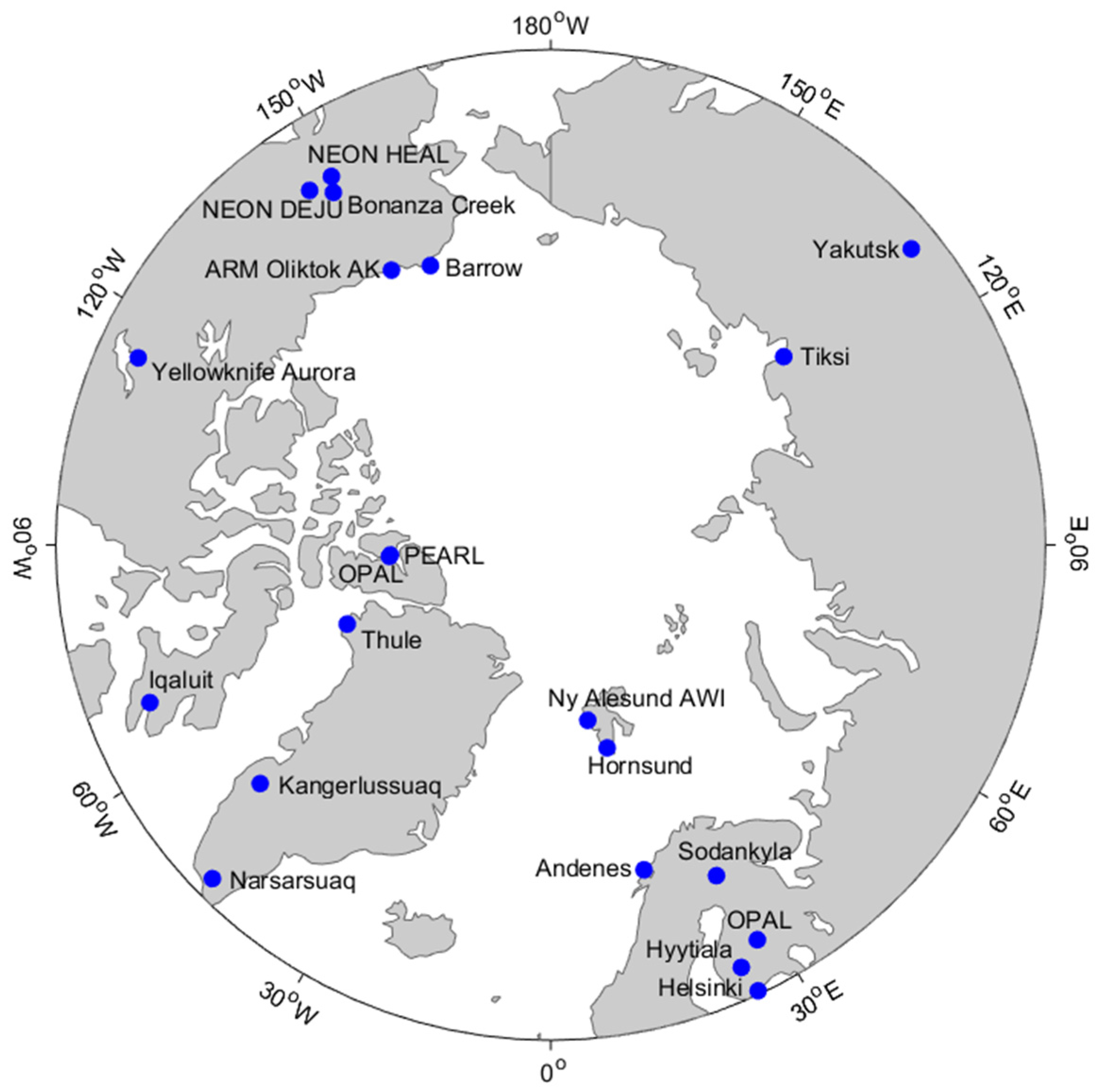
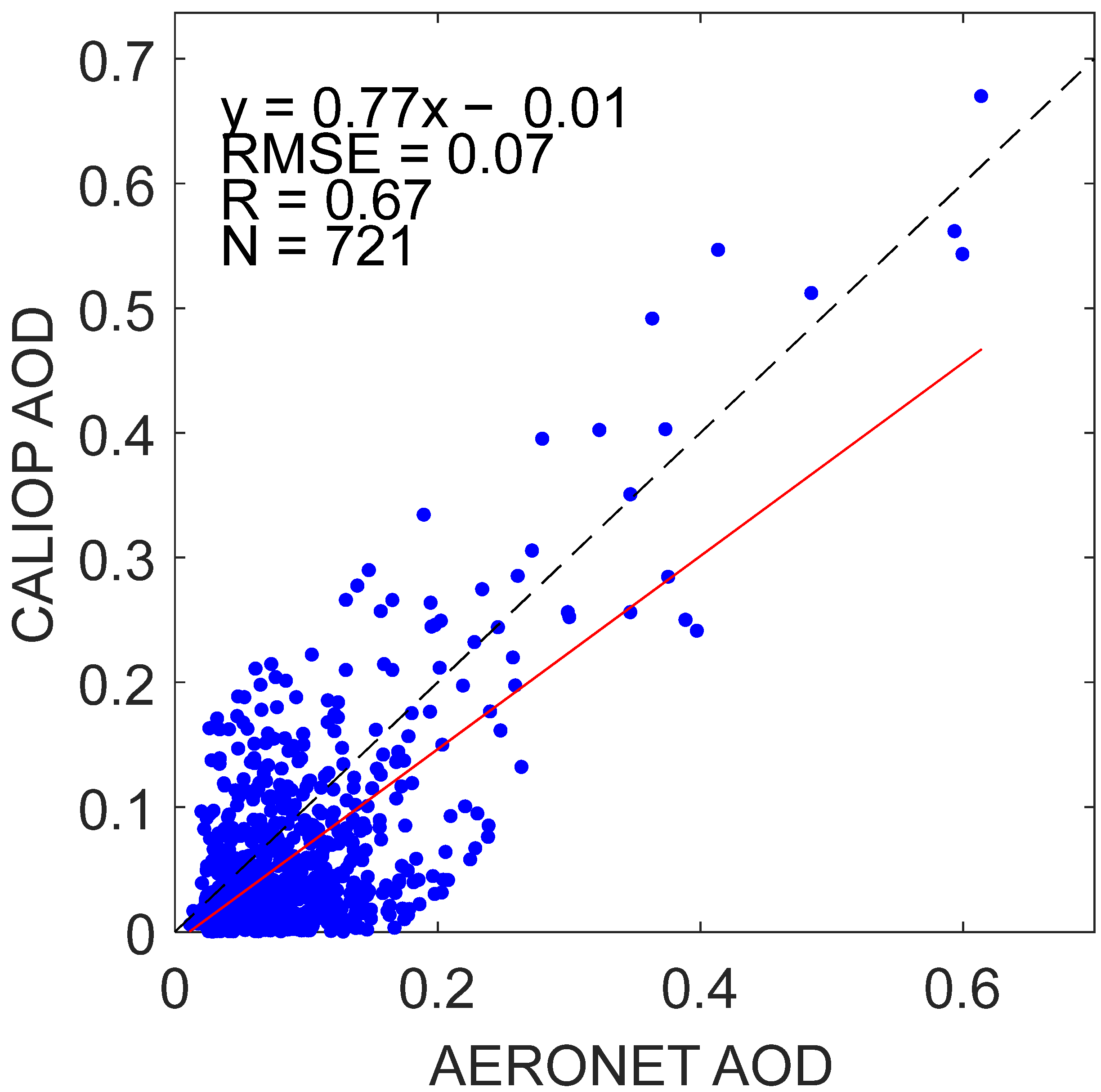

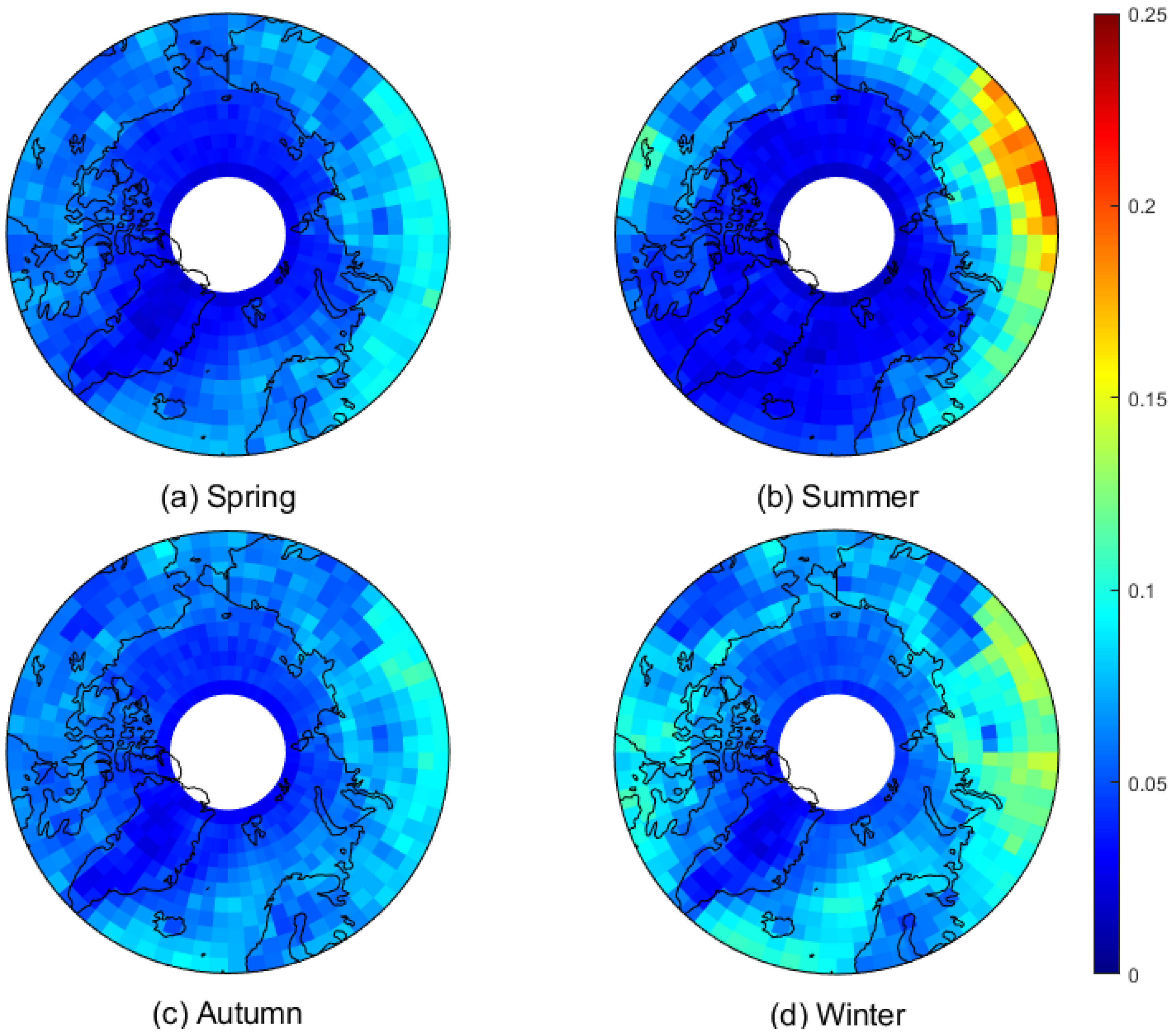
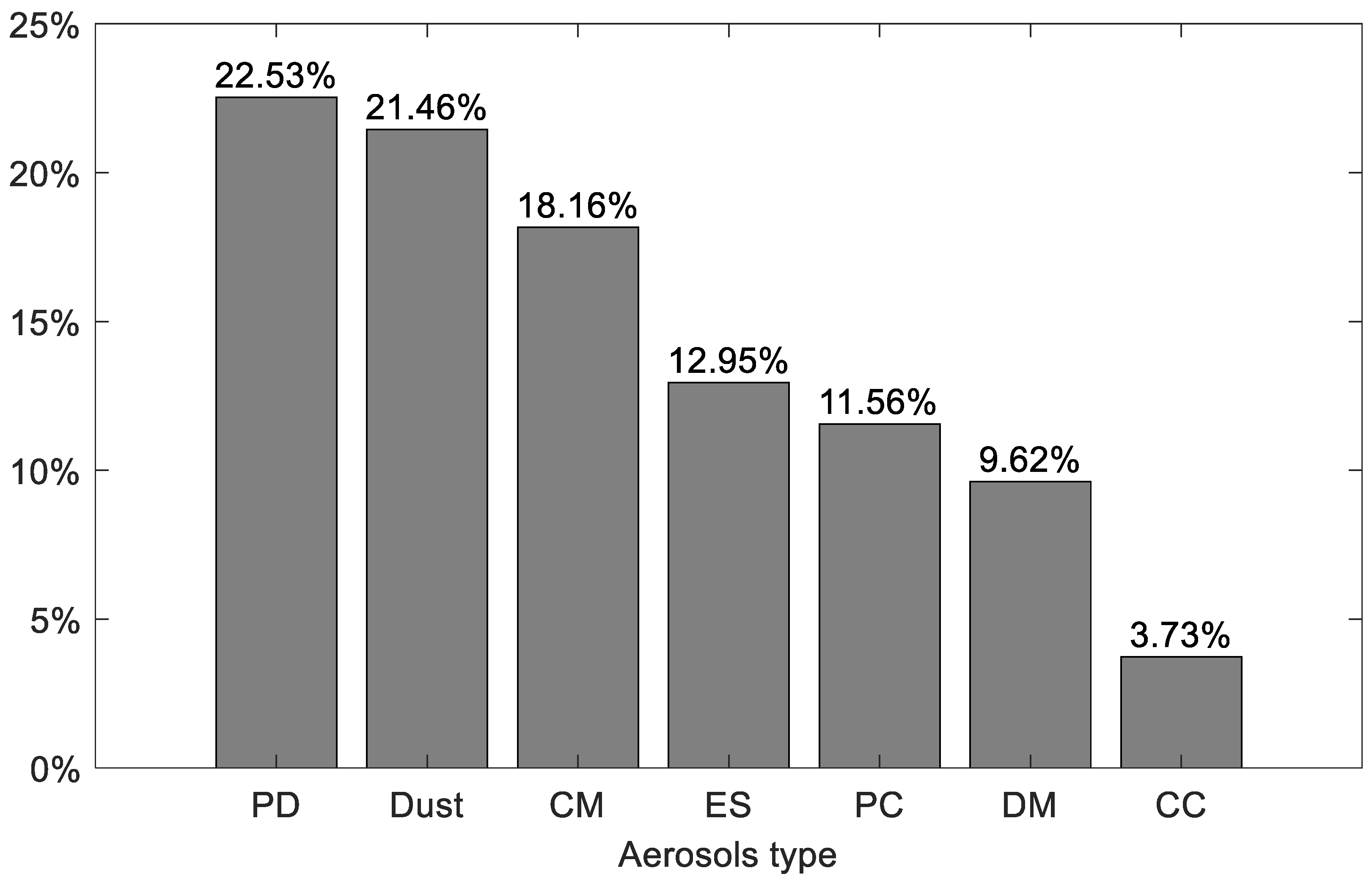
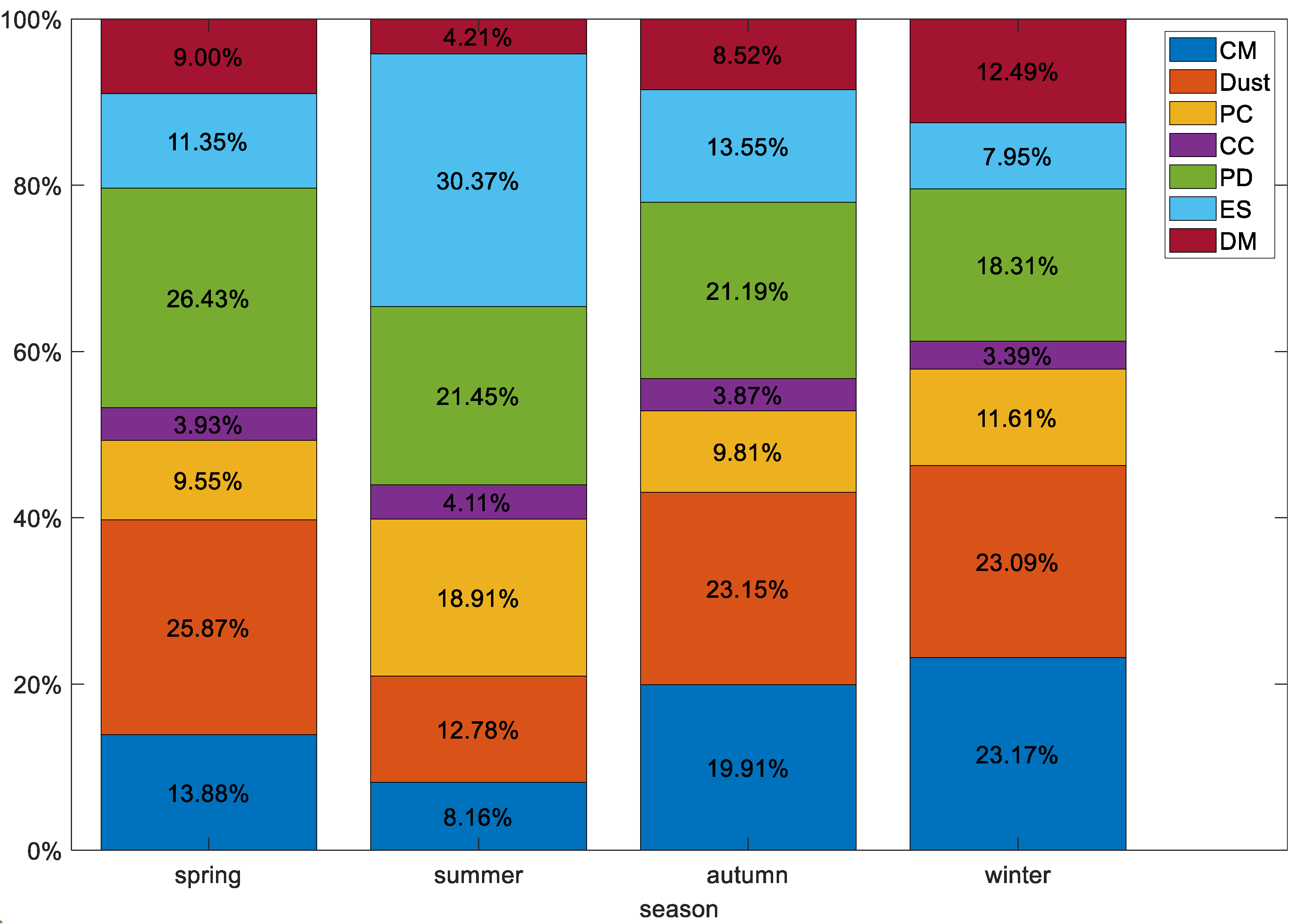

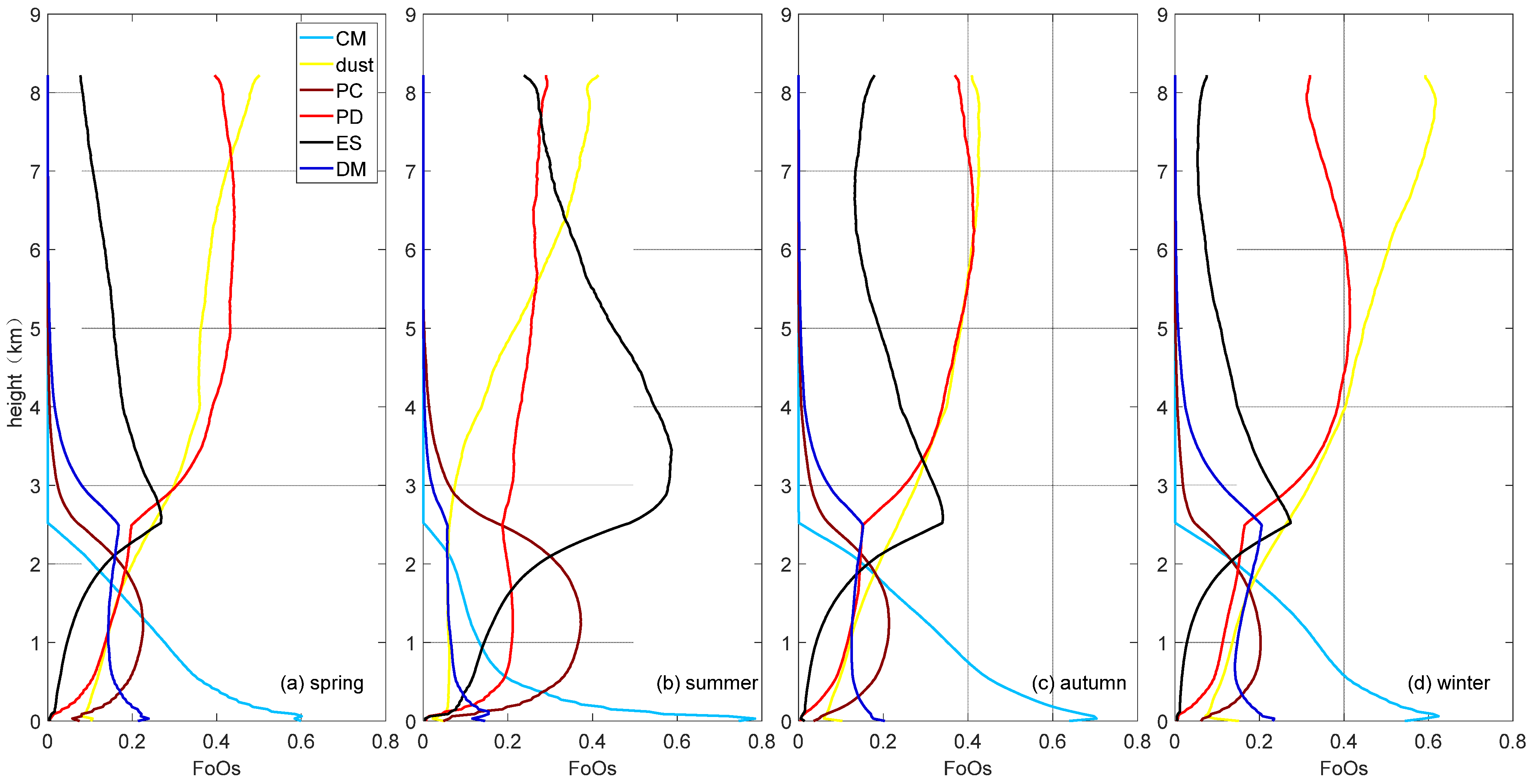
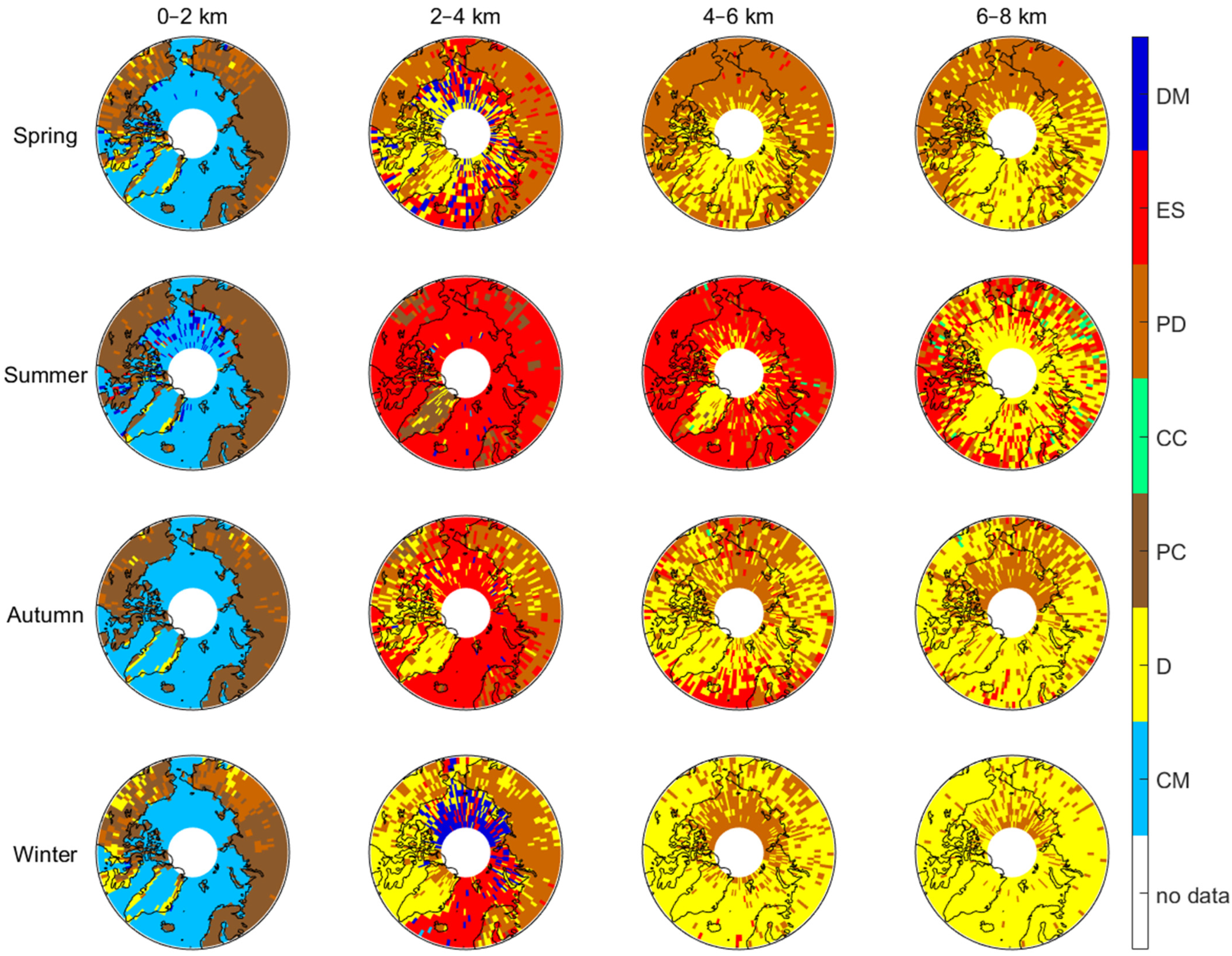

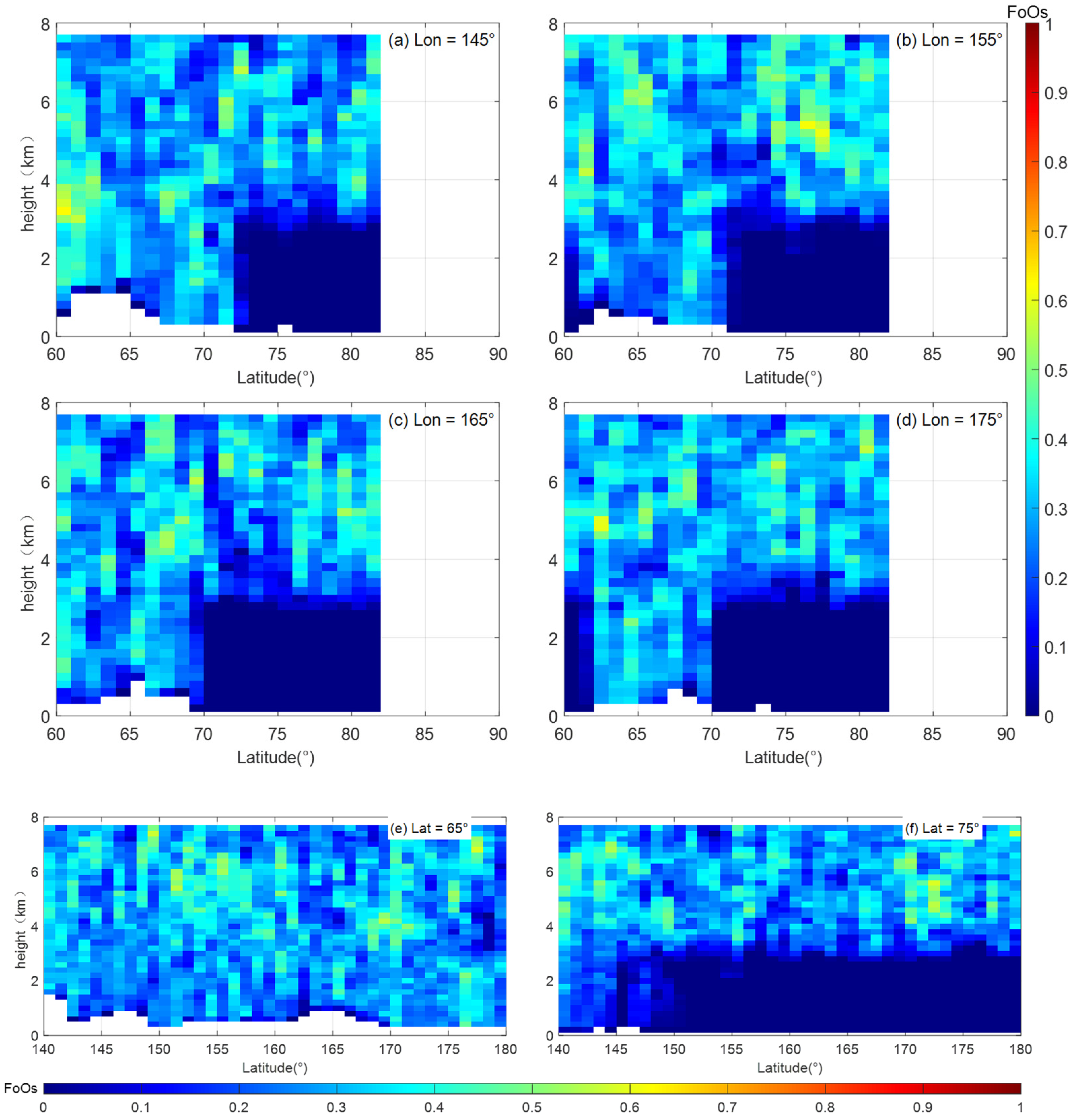
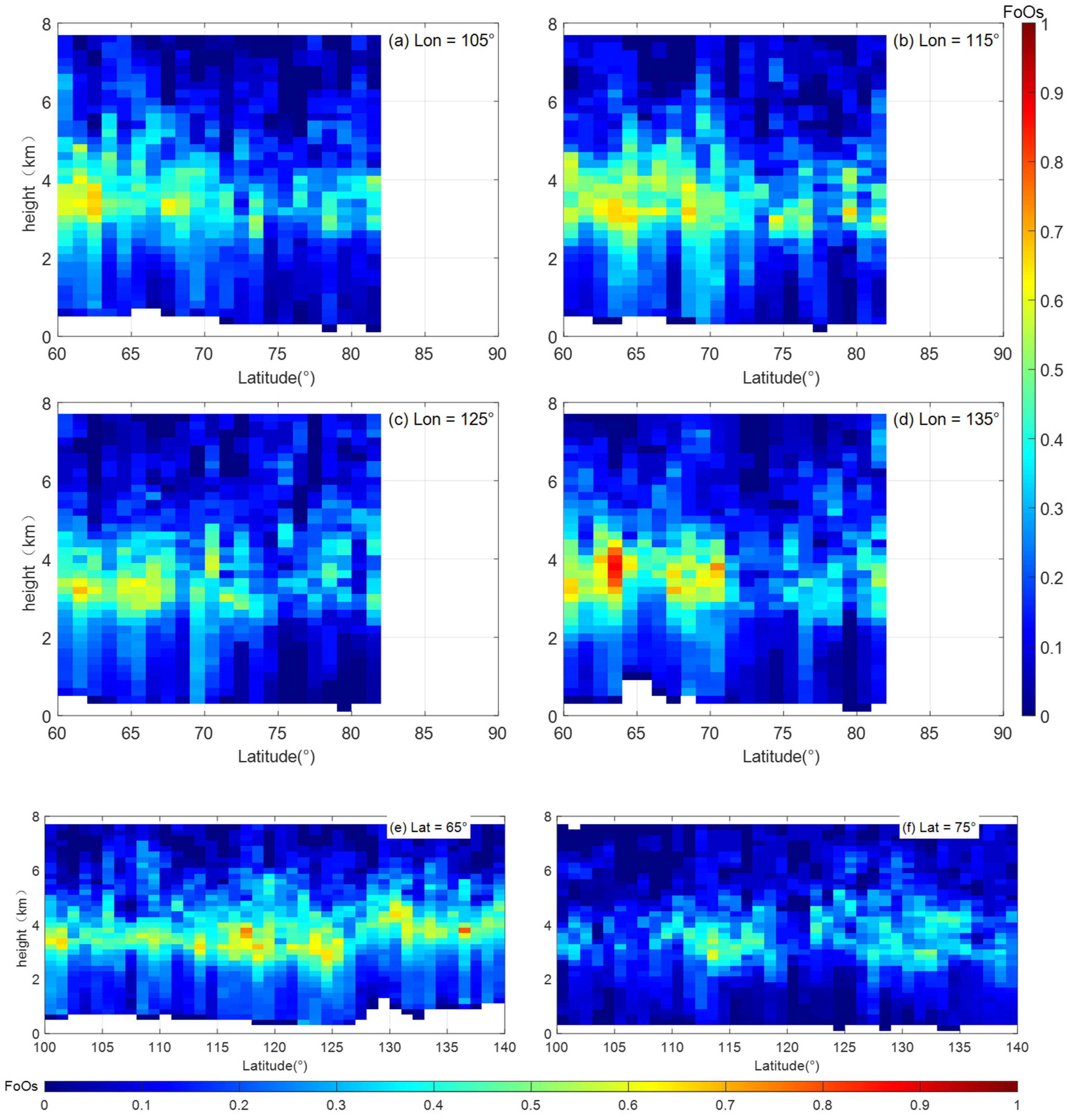
| Parameter | Value Range |
|---|---|
| Feature Optical Depth 532 Uncertainty | 0~0.1 |
| Feature Classification Flags | 3 |
| CAD Score | −100~−70 |
| Extinction QC 532 | 0,1 |
| Sites | R | RMSE | RMB | N |
|---|---|---|---|---|
| OPAL | 0.720 | 0.086 | 1.065 | 31 |
| Andenes | 0.921 | 0.036 | 0.053 | 62 |
| ARM Oliktok AK | 0.250 | 0.088 | 1.399 | 8 |
| Barrow | 0.725 | 0.074 | 0.563 | 27 |
| Bonanza Creek | 0.810 | 0.084 | 0.489 | 39 |
| Helsinki | 0.944 | 0.022 | 0.776 | 38 |
| Hyytiala | 0.820 | 0.056 | 0.690 | 34 |
| Iqaluit | 0.935 | 0.017 | 0.932 | 23 |
| Kangerlussuaq | 0.577 | 0.038 | 0.700 | 78 |
| Sodankyla | 0.530 | 0.089 | 0.736 | 24 |
| Thule | 0.964 | 0.032 | 0.478 | 28 |
| Tiksi | 0.875 | 0.052 | 0.341 | 11 |
| Yakutsk | 0.415 | 0.149 | 0.722 | 77 |
| Yellowknife Aurora | 0.560 | 0.063 | 0.677 | 70 |
| NEON DEJU | 0.159 | 0.045 | 0.450 | 13 |
| NEON HEAL | 0.954 | 0.021 | 0.657 | 21 |
| Hornsund | 0.543 | 0.056 | 0.542 | 34 |
| Narsarsuaq | 0.693 | 0.077 | 1.383 | 7 |
| Ny Alesund AWI | 0.836 | 0.015 | 1.062 | 8 |
| PEARL | 0.589 | 0.037 | 1.101 | 45 |
| Kuopio | 0.671 | 0.037 | 1.078 | 43 |
Disclaimer/Publisher’s Note: The statements, opinions and data contained in all publications are solely those of the individual author(s) and contributor(s) and not of MDPI and/or the editor(s). MDPI and/or the editor(s) disclaim responsibility for any injury to people or property resulting from any ideas, methods, instructions or products referred to in the content. |
© 2025 by the authors. Licensee MDPI, Basel, Switzerland. This article is an open access article distributed under the terms and conditions of the Creative Commons Attribution (CC BY) license (https://creativecommons.org/licenses/by/4.0/).
Share and Cite
Sun, Y.; Chang, L. Three-Dimensional Distribution of Arctic Aerosols Based on CALIOP Data. Remote Sens. 2025, 17, 903. https://doi.org/10.3390/rs17050903
Sun Y, Chang L. Three-Dimensional Distribution of Arctic Aerosols Based on CALIOP Data. Remote Sensing. 2025; 17(5):903. https://doi.org/10.3390/rs17050903
Chicago/Turabian StyleSun, Yukun, and Liang Chang. 2025. "Three-Dimensional Distribution of Arctic Aerosols Based on CALIOP Data" Remote Sensing 17, no. 5: 903. https://doi.org/10.3390/rs17050903
APA StyleSun, Y., & Chang, L. (2025). Three-Dimensional Distribution of Arctic Aerosols Based on CALIOP Data. Remote Sensing, 17(5), 903. https://doi.org/10.3390/rs17050903






